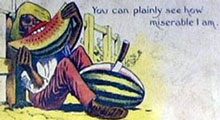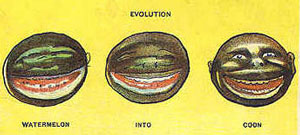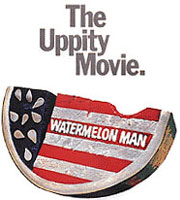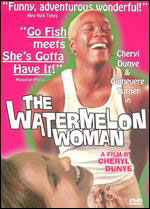Jim Crow Museum
1010 Campus Drive
Big Rapids, MI 49307
[email protected]
(231) 591-5873
Judging from the pictures on your website, you seem to be saying to me that black people don't like watermelons? Sometimes you liberals make me shake my head.
-- Amelia Myers, Delray Beach, Florida

The Jim Crow Museum itself has hundreds of images of African Americans -- usually with very dark skin, blood red grinning lips and raggedy clothes -- eating watermelons. These images on postcards, sheet music, ashtrays, and souvenirs are visual expressions of the stereotype of Blacks as ignorant, mindless buffoons. Why worry about persistent patterns of institutional racism and racial economic and health disparities when you can just eat a watermelon? The association of Blacks with watermelons is, at its root, a mean-spirited attempt to insult and mock Blacks. Keith M. Woods, from the Poynter Institute, wrote:

"Since the earliest days of plantation slavery, the caricature of the dark-skinned black child, his too-red lips stretched to grotesque extremes as they opened to chomp down on watermelon, was a staple of racism's diet. Over time, the watermelon became a symbol of the broader denigration of black people. It became part of the image perpetuated by a white culture bent upon bolstering the myth of superiority by depicting the inferior race as lazy, simple-minded pickaninnies interested only in such mindless pleasures as a slice of sweet watermelon. Like all racial and ethnic stereotypes, this one's destructive properties have, through the decades, stretched far beyond mere insult. It has helped poison self-esteem, pushing some people to avoid doing anything that seemed too 'black,' lest they be lumped into the company of Uncle Remus, Aunt Jemima, or some other relative of racism."1
Woods' essay, "Talking Race Over a Slice of Watermelon," explores the controversy of using a photograph of watermelons in a series of journalistic articles that dealt with Juneteenth, the annual remembrance of the day the last of America's enslaved black people learned they had been emancipated. After much discussion, some debate, and a lot of "I didn't know that," the journalists decided to use the photograph. They concluded that the photograph was relevant -- and though it danced close to stereotyping -- was neither malicious nor damning. During the discussions, Woods shared a personal account that I believe resonates with many African Americans:
"As we talked, I told the group how my own life had been poisoned by the stereotype. Just a few days earlier, I told them, I'd found myself in a familiar internal debate over whether to take a slice of watermelon from a luncheon fruit tray. In the pause before my fork stabbed a couple of slices, I worried anew that white people looking on would follow the crooked path of bigoted logic that says if one stereotype is validated, all the others must be true."2
Most Americans would probably be surprised to learn that African Americans are underrepresented as watermelon eaters. Blacks represent about 13 percent of the United States population yet only account for 11 percent of the watermelon consumption.3 It is possible that many African Americans are reluctant to eat watermelons because they do not want to "validate" the stereotype of the shuffling, dull-witted, clumsy, watermelon-eating Negro.

It seems almost silly to say that watermelons have been racialized, but that is exactly what happened in this culture. For much of this country's history, postcards showing Black people comically eating watermelons were popular among White Americans. Many of these so-called "Coon cards" show Black people stealing watermelons, fighting over watermelons, even being transformed into watermelons. The Jim Crow Museum houses a 1930s parlor game called, "72 Picture Party Stunts." One of the game's cards instructs players to "Go through the motions of a colored boy eating watermelon. The card shows a dark Black boy, with bulging eyes and blood red lips, eating a watermelon almost as large as he is. This is racial stereotyping as family entertainment. The museum has dozens of three dimensional objects showing African Americans eating watermelons, including banks, ashtrays, toys, firecrackers, cookie jars, match holders, dolls, souvenirs, doorstops, lawn jockeys, and novelty objects. These objects not only show Blacks lustily eating watermelons but often portray African Americans in physically caricatured ways: hideous faces, over-sized bright red lips, darting eyes, and ragged clothing. The problem is not that African Americans are shown eating watermelons. Rather, the problem is that Blacks are portrayed as contented Coons, Toms, Mammies, and Picaninnies, with all their hopes, dreams, and fears sated by eating watermelons under the shade of great trees.
The stereotypical association of Blacks with watermelons remains a common occurrence in the United States. For example, anti-Blacks jokes often include watermelons with a level of disdain toward African Americans that is reminiscent of the racial hatred common in the early 1900s. Sometimes the jokes are "hardened" by including racial slurs -- sometimes "softened" by not using racist epithets.
redneck is driving down the road one day and sees a sign that says coon season is in. He goes a bit further down the road and sees a field of niggers picking watermelons. He stops, takes out his gun and starts shooting. A cop comes up and asks him what he's doing so he says, "I saw a sign back there that said coon season was in!" The cop says, "Yea, but you're hunting in a baited field!" (From www.Racist-Jokes.com).
What's the difference between a truckload of watermelons and a truckload of nigger babies? You can't unload watermelons with a pitchfork! (From www.tightrope.cc/jokes4.htm).
[Chanted:] Basketball, watermelon, Cadillac car.
We ain't as dumb as you think we . . . is.
(From www.polymath-systems.com/misc/jokes/black.html)
In 1947, the year Jackie Robinson broke Major League Baseball's color line, he was confronted with race-baiting taunts and crowds that threw garbage, tomatoes, and watermelon slices at him. In 1989, Blacks protesting the killing of a Black boy by Whites in Bensonhurst, New York, were taunted by Whites, some of them holding watermelons above their heads, yelling, "Go home, Niggers go home." In 2001, a debate in the Mississippi statehouse on whether the state flag should be retired (it included the Confederate battle flag in one corner) degenerated into shouting diatribes. An African American senator was mocked with references to a watermelon as he spoke, and another was told he was lucky his ancestors were slaves. There are literally hundreds of instances in recent years where the watermelon (and its supposed association with Blacks) has been used as a tool of insult against African Americans.

African Americans have used the watermelon as a means to deconstruct patterns of racism. I am reminded of Watermelon Man (1970), a blunt, satirical comedy-drama directed by Melvin Van Peebles. This is the story of Jeff Gerber, a boorish and racially prejudiced White insurance salesman living in the 1960s, who wakes up one morning to discover that he has inexplicably metamorphosed into a Black man, a very black man. At first, Jeff believes he is dreaming, and failing that, that he has spent too much time under the tanning machine. He tries to wash the black off. He goes to a doctor, who cannot help him, and suggests that he see a Negro physician. Jeff goes to the "colored part of town" in order to find "the stuff they use in order to make themselves look white." All of his attempts to change his skin color fail. Jeff's position on America's racial hierarchy has changed and he now has a vantage point from the bottom up. He chases a bus and a police officer stops him and accuses him of stealing. Why? Because why else would a Black man be running? He gets threatening calls at home from a man telling him to "move out, nigger." His wife, Althea, is understandably confused by Jeff's new appearance, and though she considers herself a liberal, she asks if she should hide the family's money -- and serves him fried chicken and watermelon for dinner. His boss likes the idea of having a "Negro" salesman. His White secretary now finds him sexually appealing. He arrives home one evening to find the racists who made the threatening phone calls. They really want him out of the neighborhood and offer him $50,000 for his home. Jeff plays on their racism (and fears that his black-skinned presence will decrease the value of their homes) and gets the price raised to $100,000, a great sum at that time. Althea, his wife, sends their children to live with relatives and later decides that she cannot live with a Negro. Finally accepting his fate, Jeff quits his job, buys an apartment building, and starts an insurance company.

In 1996, Cheryl Dunye, raised the ire of many conservatives with her mock documentary, Watermelon Woman. The movie follows the life of Cheryl (played by herself), a young Black woman working as a video store employee who wants to be a director. She decides to make a documentary about Fae Richards, an obscure 1930s Black film actress popularly known as "the Watermelon Woman." Cheryl discovers that Fae, who often played stereotypical Mammy roles in Hollywood films, was the secret lover of a White director, Martha Paige. While researching and probing the meaning and mysteries of Fae Richards' life, Cheryl experiences drama in her life. Her love affair with Diana, a white woman, creates conflict with her Black friend, Tamara, who also wonders aloud about Cheryl's commitment to the Black community. Much of this "mockumentary" consists of interviews, including one with well-known social critic Camille Paglia who delivers a bizarre monologue about her perception of the symbolic meaning of a watermelon. Watermelon Woman was a low-budget masterpiece. Although Fae Richards was fictional, the issues of racism and homophobia are real. Not surprisingly, Senator Jesse Helms -- preoccupied with the film's single, graphic but tasteful and brief sex scene -- referred to the film as flotsam floating down a sewer."
That the Jim Crow Museum website lacks or includes images of Blacks with watermelons has nothing to do with whether or not Blacks like watermelon. I hope you understand that such images are part of the ugly story of racism, hate and harm that we try to tell in order to promote racial understanding and healing.
Finally, I wish all Americans ate more watermelons. A one-cup serving of watermelon will provide just 48 calories. People concerned about their weight would benefit by substituting watermelons for some of the foods they eat. Watermelon is an excellent source of vitamin C and vitamin A, with one serving containing 14.59 mg of vitamin C and 556.32 IU of vitamin A. Watermelon also offers significant amounts of vitamin B6 and vitamin B1, as well as magnesium and potassium. The health benefits of watermelons are many. That watermelons are associated with Blacks shows the power of racial stereotyping, which in turn explains why some African Americans will not eat watermelons -- and this shows how racial stereotyping permeates American culture.
1 Keith M. Woods, "Talking Race Over a Slice of Watermelon." Poynteronline. Accessed April 21, 2008. http://www.poynter.org/content/content_print.asp?id=42722&custom=.
2 Ibid.
3 Gary Lucier and Biing-Hwan Lin. "Factors Affecting Watermelon Consumption In The United States. Accessed April 24, 2008. http://www.ers.usda.gov/Briefing/vegetables/vegpdf/WatermelonFactors.pdf.
May 2008 response by
David Pilgrim
Curator
Jim Crow Museum